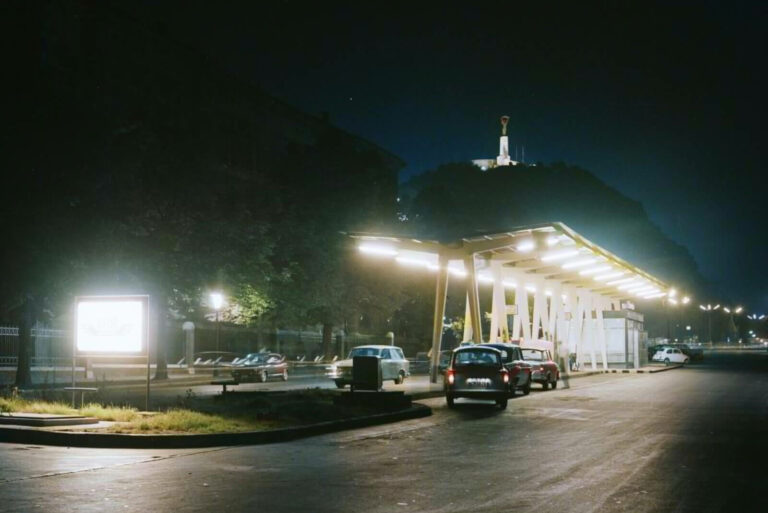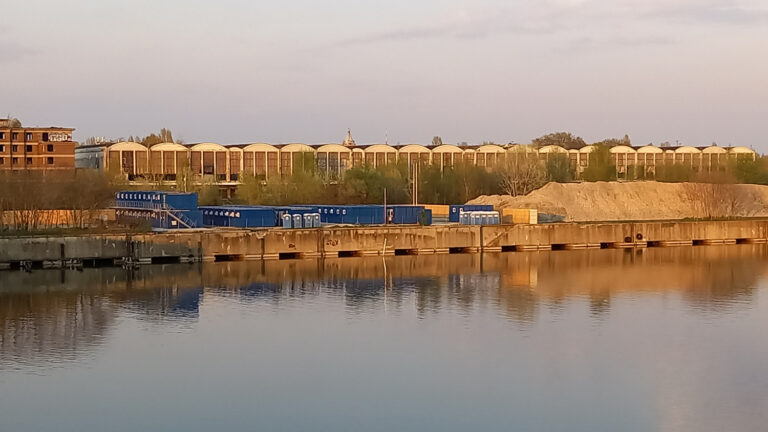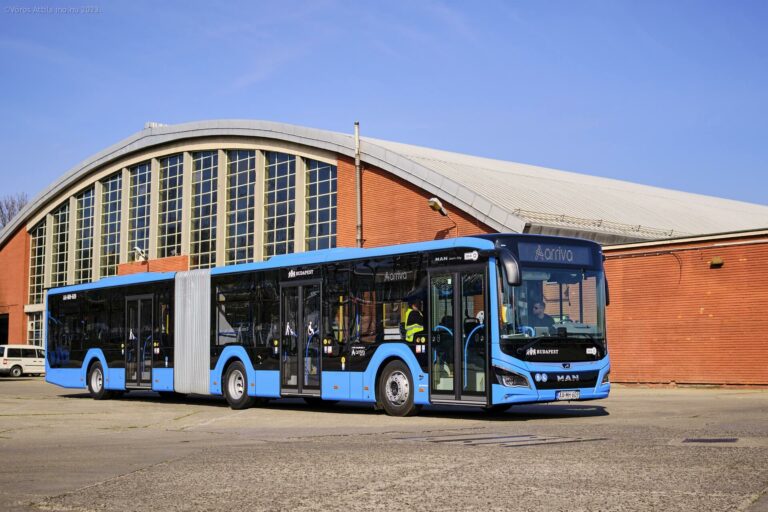1973-2017 - The Martinelli (Servita) Square car park
Architecturally and commercially unsuccessful, the country's first car park in the heart of Pest's city centre left its mark on one of the capital's most patinated squares for decades.
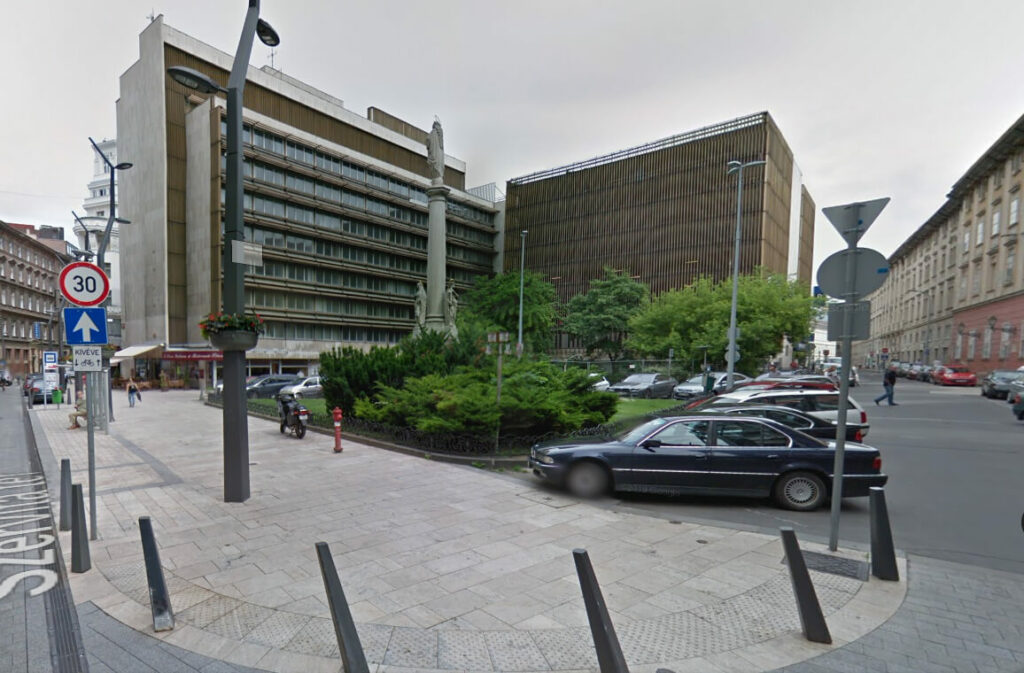
The 2014 situation on Google Maps.
But the intention was noble.
In the early seventies, the then called Martinelli Square in Servita was already suffering from poor parking conditions. At the time, the number of cars in the country was only around 250 000, but the area attracted so many cars on weekdays that demand was far outstripping supply. At that time, parking was not yet prohibited on nearby Vörösmarty and Engels (Elisabeth) squares, but the situation was illustrated by the fact that even at 100% occupancy, only 120 and 150 cars could wait at a time.
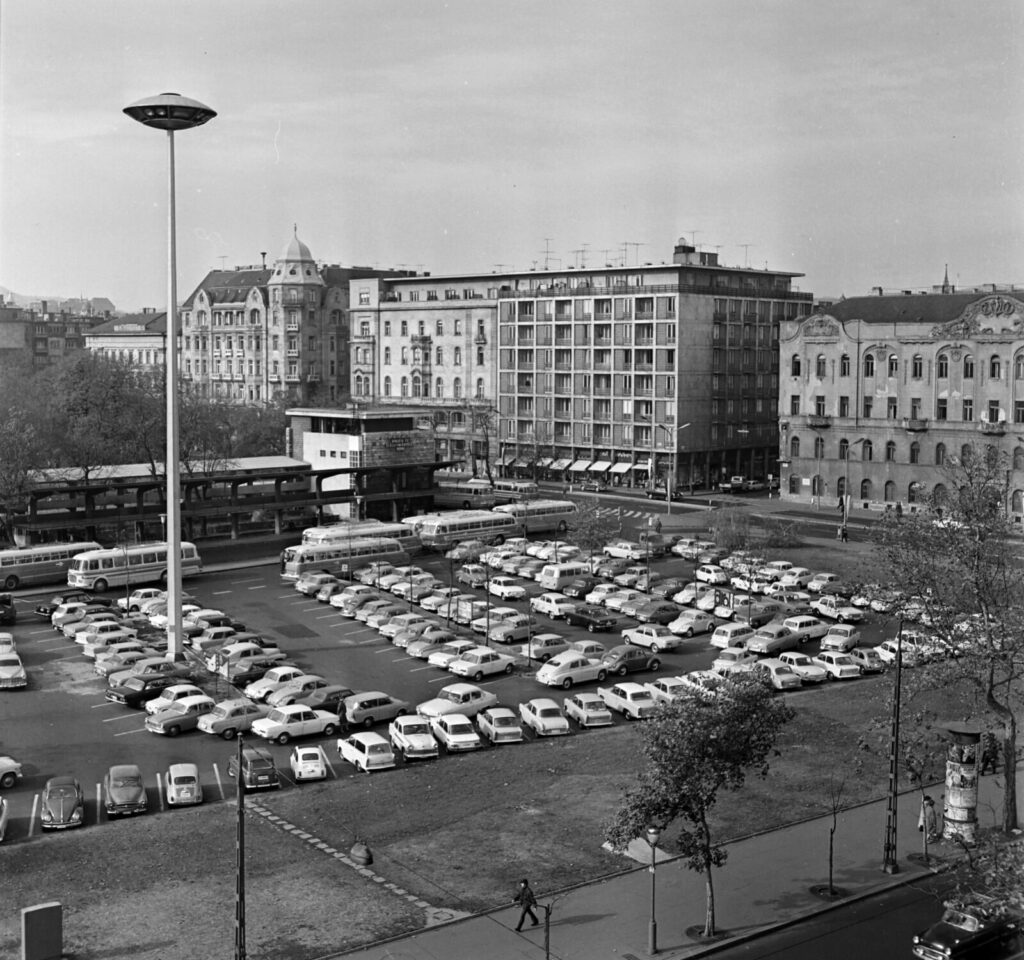
Hungary, 1970, Budapest V. Erzsébet (Engels) Square, the parking lot and the MÁVAUT bus station seen from Bajcsy-Zsilinszky út - Image source: Fortepan 195405 / Bojár Sándor
There was a need for much more.
The truth is that there was originally no question of building a car park. The idea was that the OMFB (National Technical Development Committee) would issue a call for tenders for the construction of its own office building, but with the support of the Metropolitan Council, the proposal of the KÖZTI to build a parking garage in the areas that would not be built but would be affected by the works - with the involvement of Interag - was put forward.
Unfortunately.
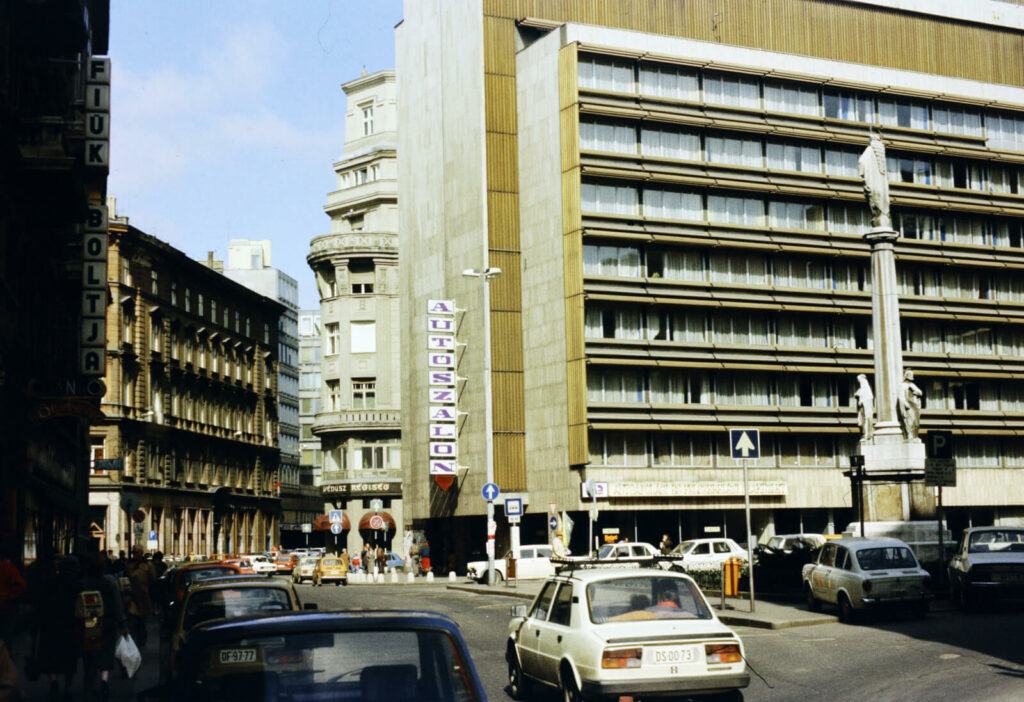
Hungary, 1988, Budapest V. Szervita (Martinelli) Square, St. Mary's Column, in the background the headquarters of the National Technical Development Committee (OMFB). To the left, Kristóf Square and Bécsi Street. - Image source.
For such an intimate space, it is impossible to dream up a building (or two) of this size without drastically overthrowing the proportions, but the situation was made even more difficult by the fact that the target date for completion was August 1971 (ready for occupation), while the plans were not ready until July 1970.
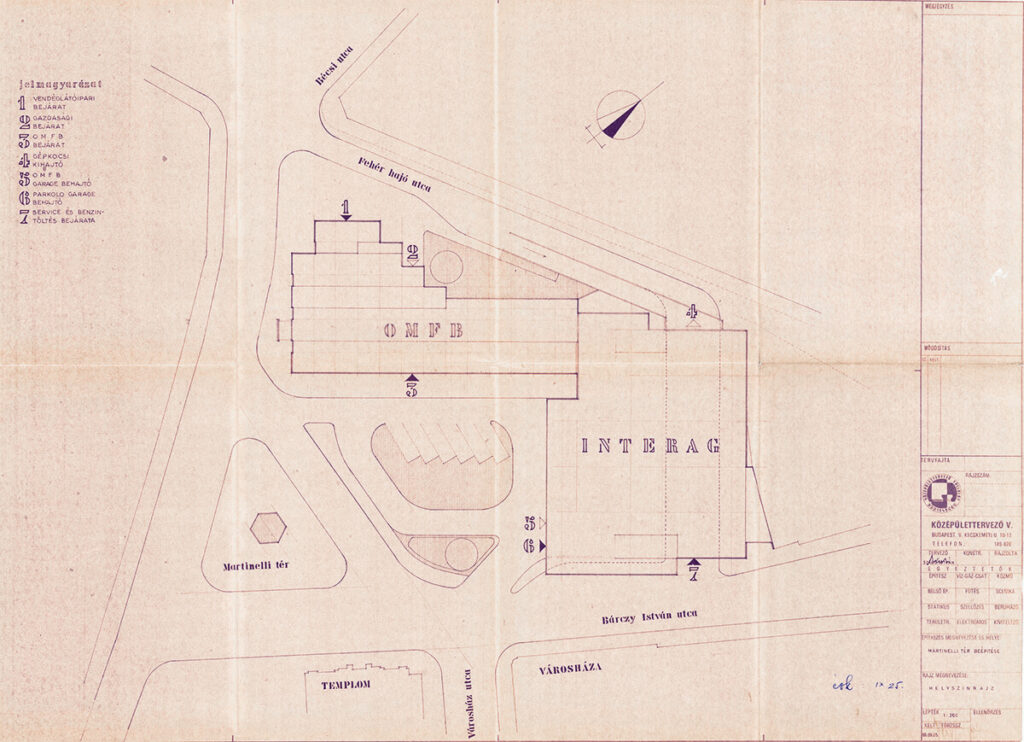
Site plan of the Martinelli (now Szervita) Square office and car park. Image source: lechnerkozpont.hu / Lechner Knowledge Centre, Documentation Centre / Design Library, Public Building Design Company
The square, and the former Teleki Palace on the square, were so badly damaged in the 1945 bombing raids that they were later demolished.
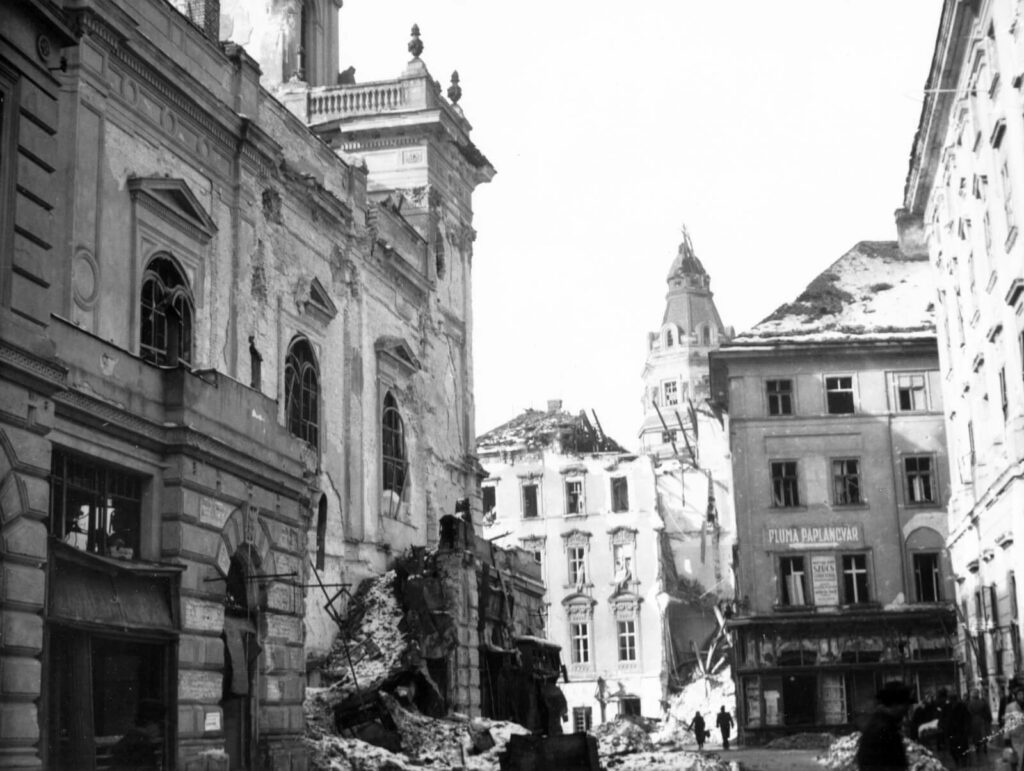
Hungary, 1945, Budapest V. Városház utca, St. Anne's Church (Servite Church) in the city centre on the left, in the distance on Servite Square in the background the destroyed Teleki Palace, the dome of the house on the corner of Bécsi utca and Fehér Hajó utca - Image source: Fortepan 60134 / Fortepan
The area was transformed into a "square" after the redevelopment, the triangle bordered by Fehérhajó-Petőfi Sándor-Bárczy István streets was practically empty: for almost twenty-five years it was home to a park and a playground.
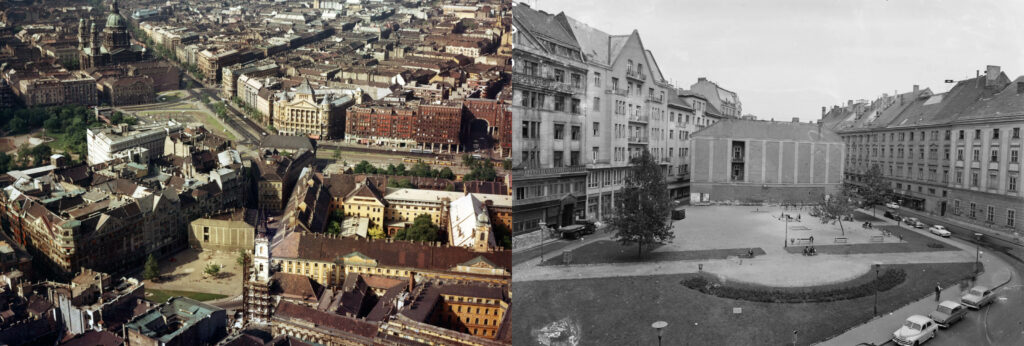
The state of the square in the 50s and 60s from a bird's eye view and from Bécsi utca - Image source: Fortepan 13205, Kecskés András and 91847, UVATERV
The construction of the OMFB office building and the car park started here in the second half of 1970 and, with compromises, the office building was completed by the end of 1971 with a speed uncharacteristic of the time. The handing over of the car park was postponed to 1973 due to "financial difficulties".
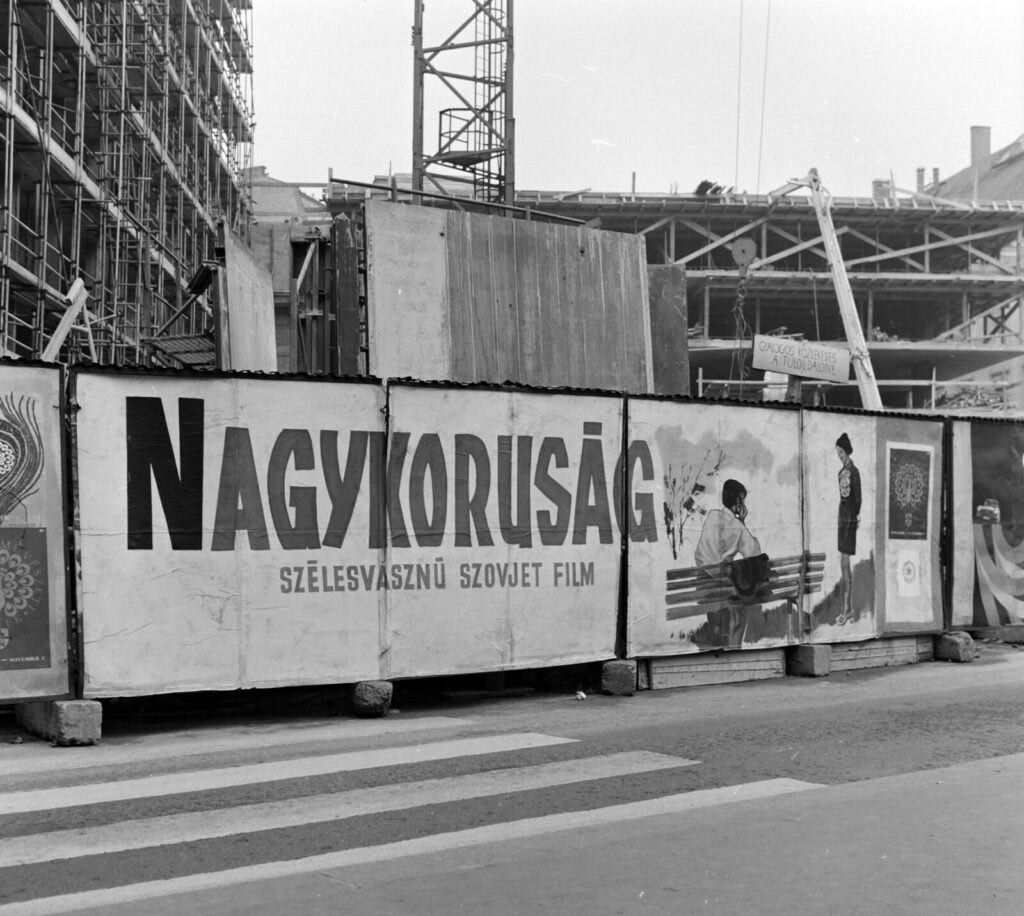
Hungary, 1970, Budapest V. Szervita (Martinelli) Square, construction of the parking and office building. The poster of the film distributed by the Budapest Cinema Company (FŐMO) on the slab. - Photo source.
Finally, on 25 June 1973, the eleven-storey "INTERAG" building was opened at a cost of 47 million forints. The OMFB office building cost another HUF 52 million, so the total cost of the project was over HUF 100 million, which would be around HUF 8.5-9 billion at today's prices.
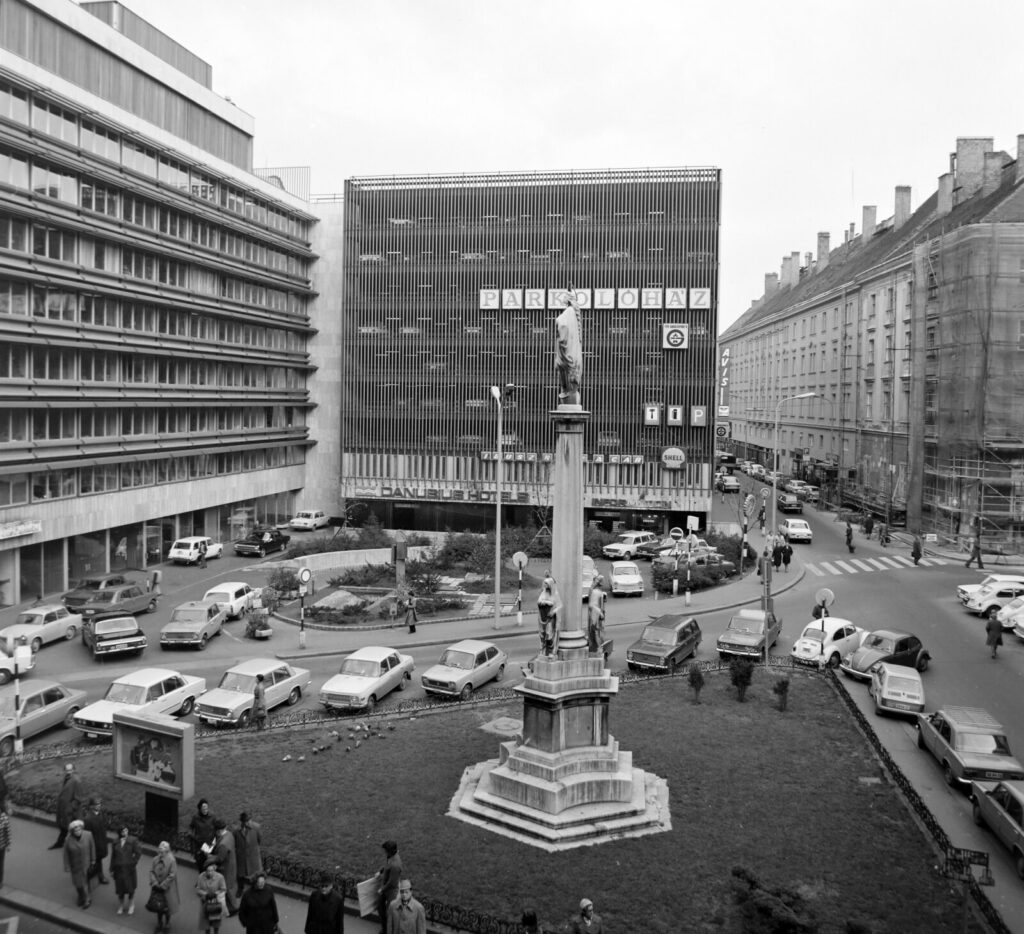
Hungary, 1976, Budapest V. Szervita (Martinelli) Square, in the foreground the Mary Column. On the left is the headquarters of the National Technical Development Committee (OMFB), opposite is the Interag parking garage, on the right is Bárczy István Street. - Image source.
It opened and failed almost immediately.
After the obligatory rounds in July - "opened", "handed over", etc. - critical voices in the press began to intensify in August '73: first, negative comments on the cityscape - already accompanying the construction - were focused on, but soon opinions on the quality of the construction also appeared. The district council's building department refused even to issue a permit for the car park, according to a statement at the end of the year, because of serious defects that prevented the building from being used as intended - accidents, damp, fire, etc. - and the risk of cars being damaged.
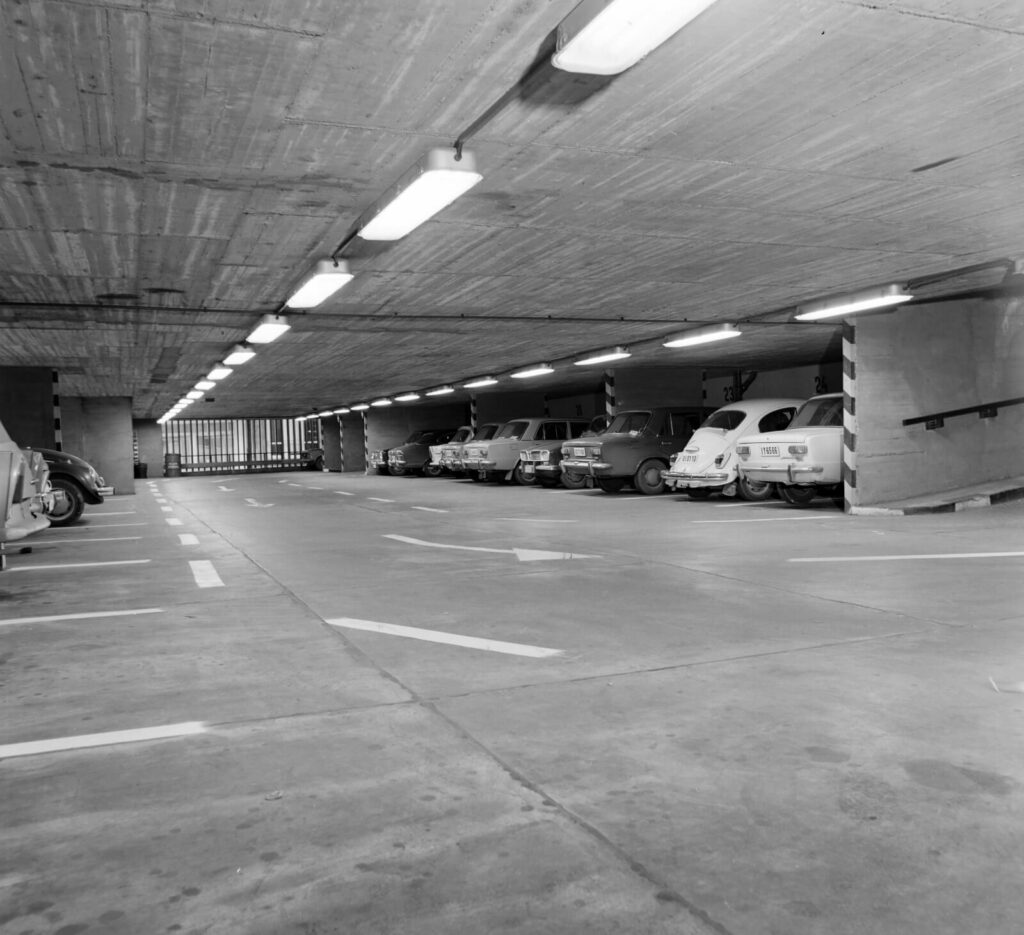
Hungary, 1976, Budapest V. Szervita (Martinelli) tér, parking garage. - Image source.
But...
It could have been a success once it was built, but despite its modest capacity of around 350, there was hardly ever a time when there was no room for a new arrival. Accordingly, of course, the square was not the least bit less crowded. When asked why they did not use the car park, motorists who often parked in the area around the building, often illegally, invariably cited the price as the main reason.
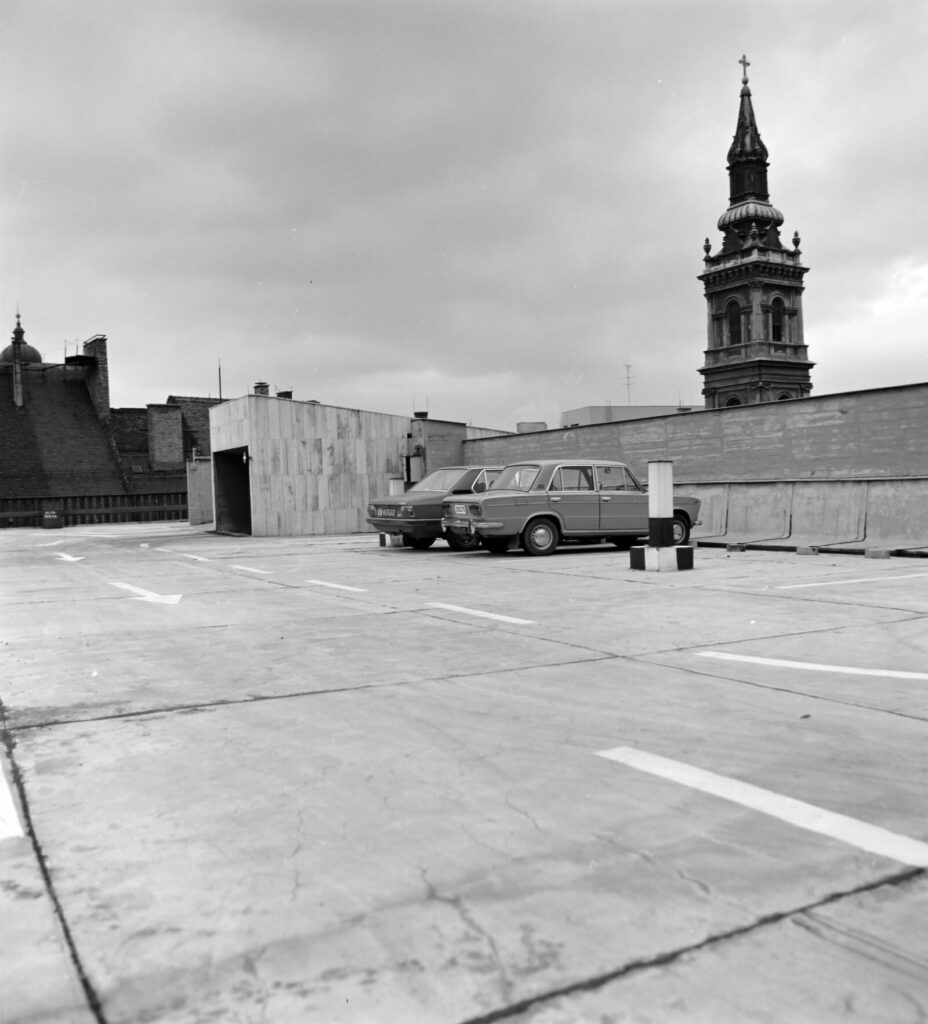
Hungary, 1976, Budapest V. Szervita (Martinelli) Square, taken on the roof of the parking garage. In the background you can see the steeple of the St. Anne's Church (Servite church) in the city centre. Image source.
Prices: at the opening, each hour started cost 5 forints, eight hours cost 30 forints. (For comparison: according to the Hungarian Central Statistical Office, the average per capita income in Hungary in 1973 was 2,629 forints.) At the same time, the street pay was two forints per hour.
For an hourly rate of five forints, the building also offered a service desk in the basement, open from 6am to 10pm, and a non-stop Shell well.
But they didn't come.
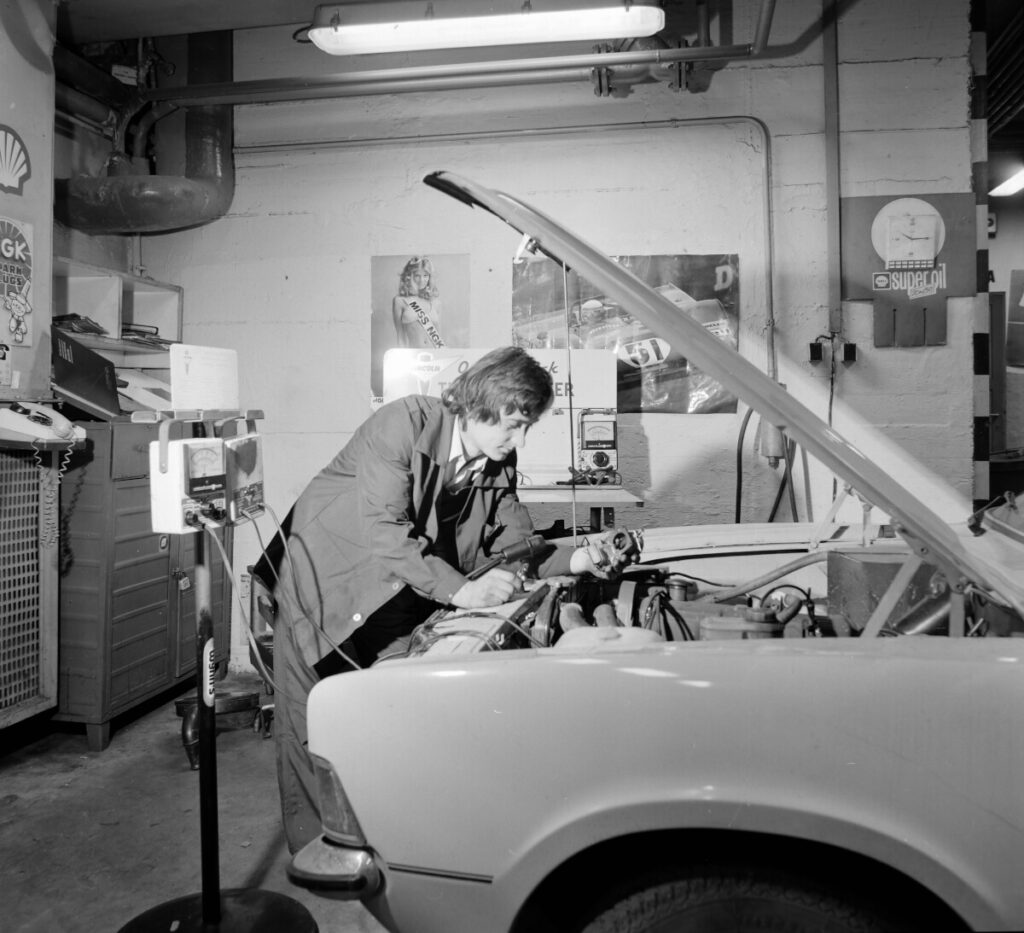
Hungary, 1976 Budapest V., Szervita (Martinelli) tér, parking garage service. - Image source.
According to 1975 figures, the average daily occupancy rate of the garage was only 7.6% in that year, and the annual average at the peak occupancy period between 13 and 14 hours was only 14%. These figures are particularly bad in view of the fact that the number of parking spaces had also fallen considerably in the meantime, because the under-utilisation was somewhat remedied by giving the first level over to the IBUSZ rental car fleet one by one, and by reserving many spaces for cars from the 18 or so different companies involved in the project.
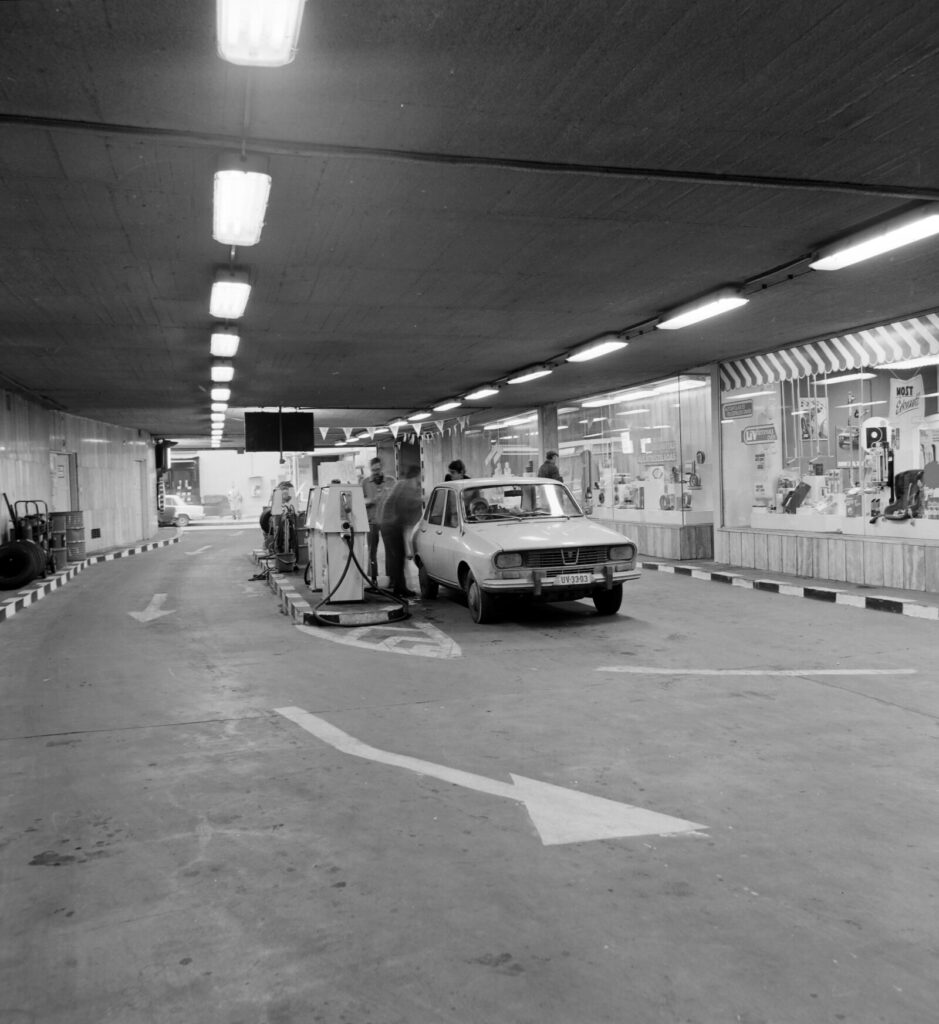
Hungary, 1976 Budapest V., Szervita (Martinelli) tér, parking garage petrol station. - Image source.
Throughout the seventies and eighties, the daily, weekly and weekly newspapers ran a steady stream of advertisements popularising the car park, with little success.
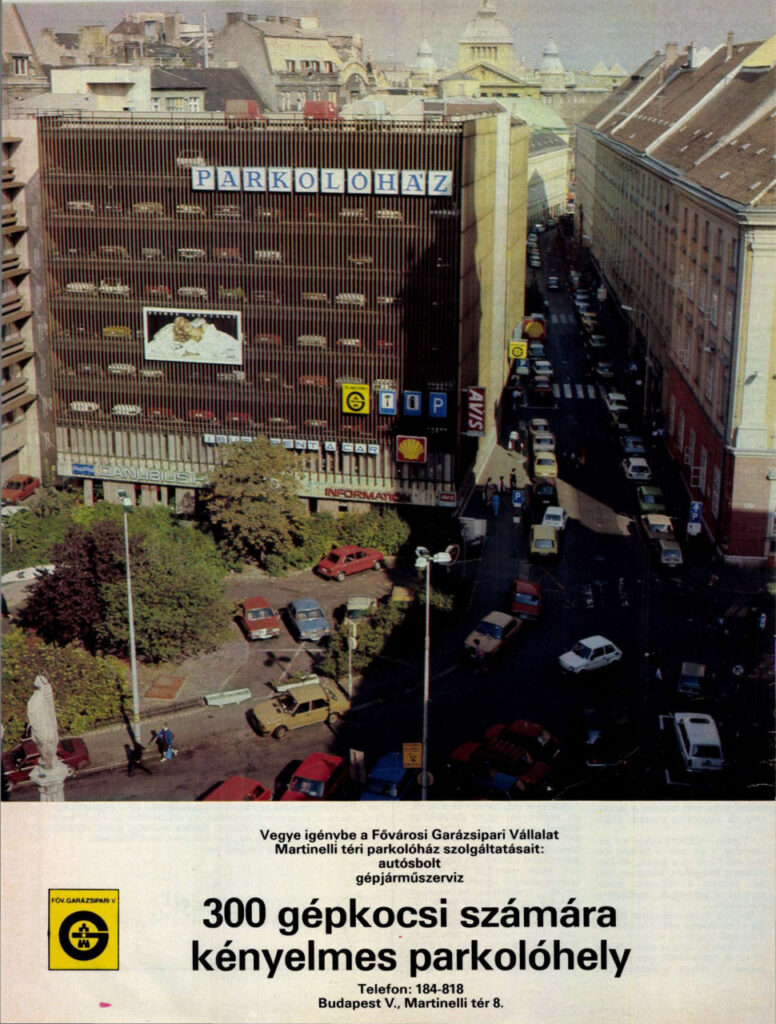
One of many advertisements from Képes7, 1988 Image source: Képes7 / Arcanum
After the change of regime, the occupancy rate soared, typically hovering around 100 percent, due to increased demand. At the same time, the building was ageing badly: the upper floor, for example, which had been leaking from the start, would have needed a complete roof replacement, and the narrow turns and anomalies in the interior spaces could not be economically adapted to the needs of the new age.
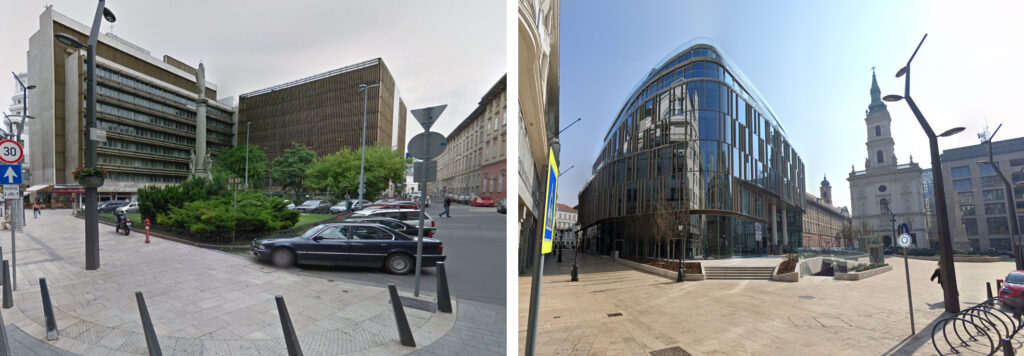
Google maps images of the square in May 2014 and March 2021
After two decades of agony - a long agony - and after numerous changes of ownership and many failed master plans, the building was demolished in 2017. In its place, an exclusive parking and office building with seven above-ground and five below-ground levels was built with luxury apartments on the upper floors. The Szervita Square Building, as it is called, with its large mirrored surfaces, fits more organically into the space than its infamous predecessor, proving that the almost futuristic modern can fit well into a historic environment, if it is not meant to be overpowered but to be multiplied by mirrors.
